A Common Methodology for Risk Assessment and Mapping of Climate Change Related Hazards—Implications for Climate Change Adaptation Policies
Abstract
:1. Introduction
2. Disaster Risk Reduction, Climate Change Adaptation, and the Role of Risk Assessment
2.1. Climate Change Adaptation and Disaster Risk Reduction
- (1)
- Considering gradual changes in average temperature, sea level and precipitation, and adapt development accordingly, and
- (2)
- Management and reduction of the risks that are related to extreme weather events.
2.2. Risk Assessment and Its Role in Disaster Risk Reduction and Climate Change Adaptation
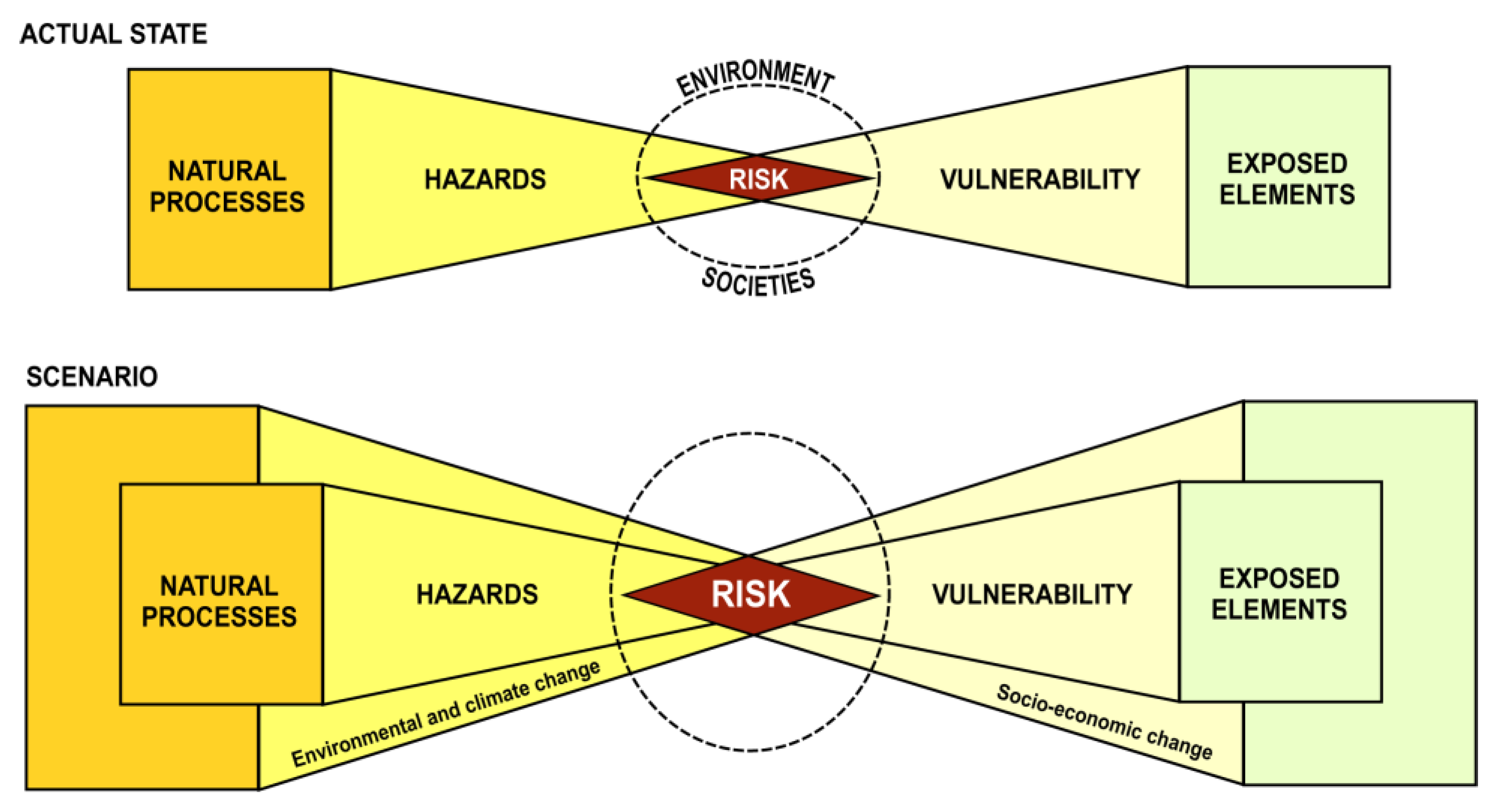
Risk Assessment Efforts in the Study Area
3. Development of a Common Risk Assessment Methodology (CRAM)
3.1. Case Study
| Country | Hazard Type | Element at Risk | Scale |
|---|---|---|---|
| Bulgaria | Wildfire | Forest | Local |
| Bosnia Herzegovina | Flood | Buildings | Local |
| Hungary | Extreme wind | Buildings/Population | Local |
| Romania | Heat wave | Population | Local |
| Serbia | Drought and drought related wildfire | Crops | Local |
| Slovakia | Flood | Population | Local |
- Literature review
- Questionnaire
- Analysis of questionnaire results
- Design of a general methodology
- Methodology development for specific hazard types
- Extension of the methodology to consider global change
3.2. Design of the CRAM
- Needs and expectations of the individual partners
- Relevant hazards for each case study area and priorities.
- Legal requirements at the national level.
- Existing products (e.g., risk maps, risk matrices, hazard and vulnerability maps, risk scenarios, etc.)
- Existing data, as well as their availability, quality, format, and scale.
4. Blueprint for the CRAM
- The lack of a common language (terminology)
- The lack of appropriate data (of the required quantity, quality, scale, format, and accessibility)
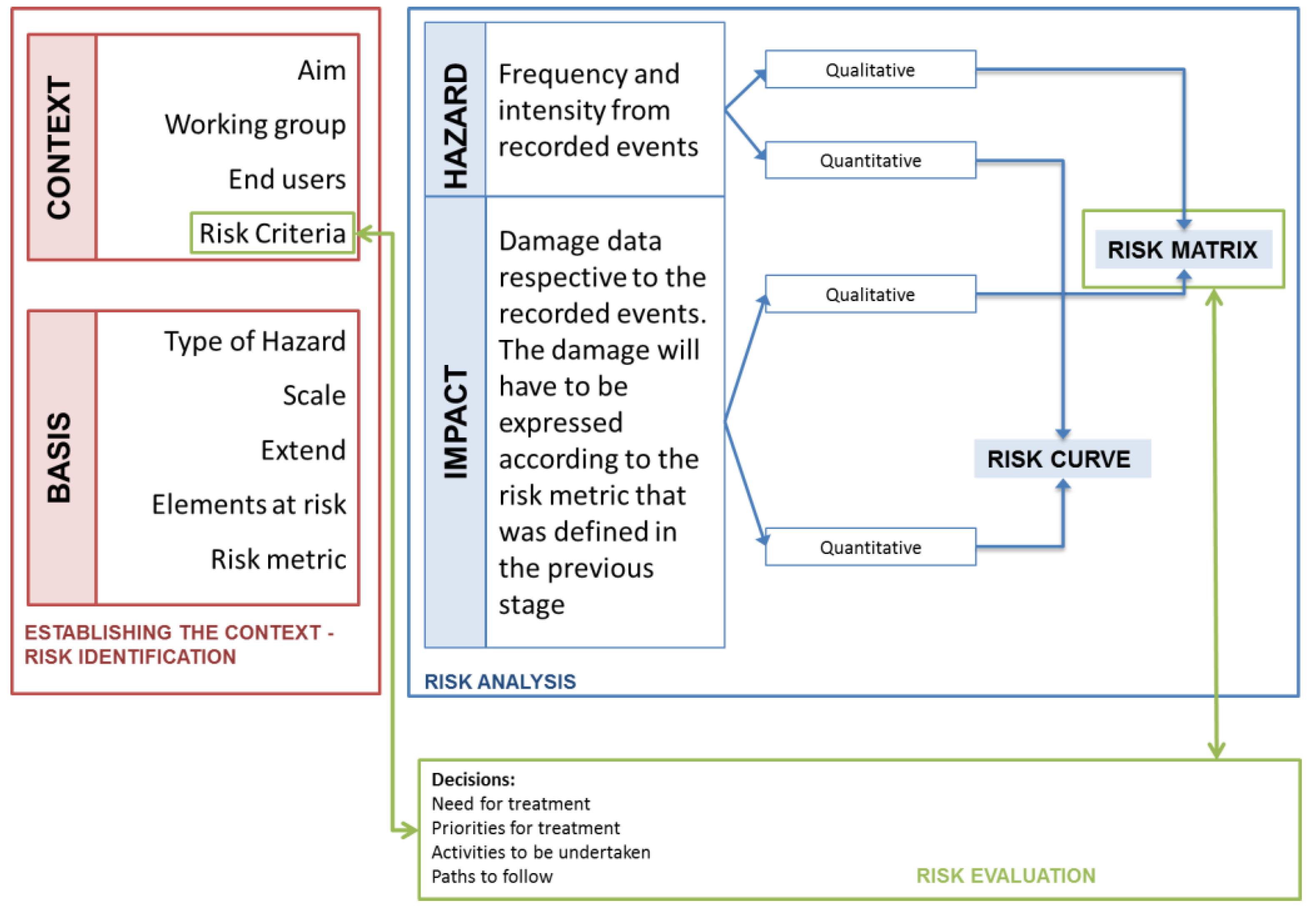
4.1. Risk Identification
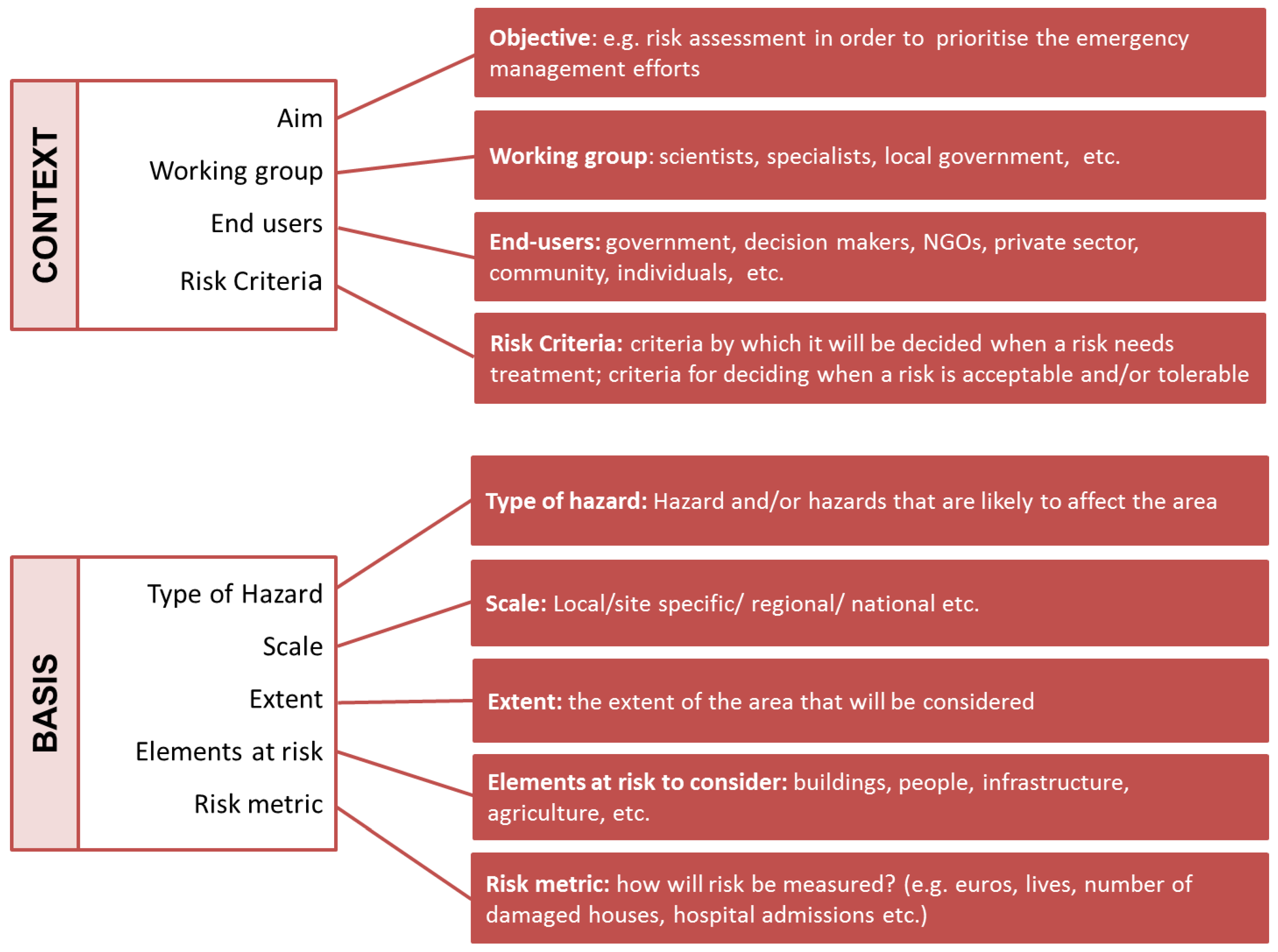
4.2. Risk Analysis
4.2.1. Qualitative Risk Analysis—the Risk Matrix
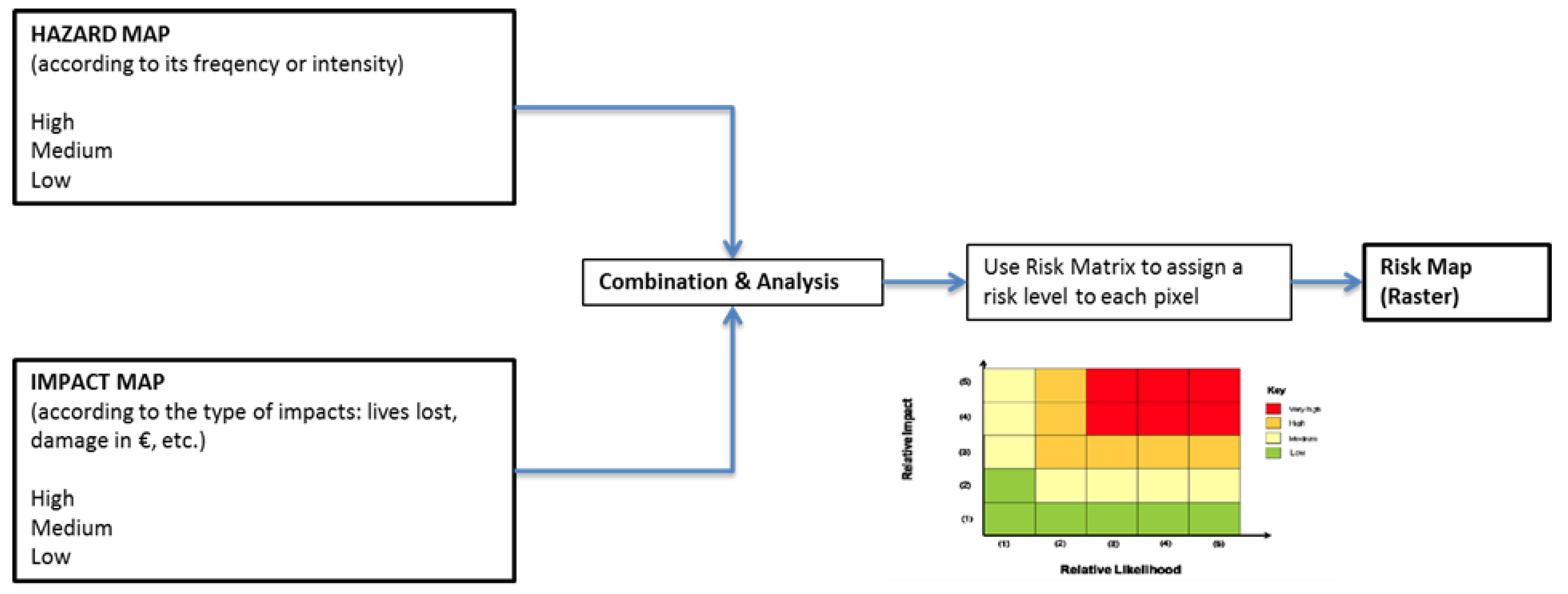
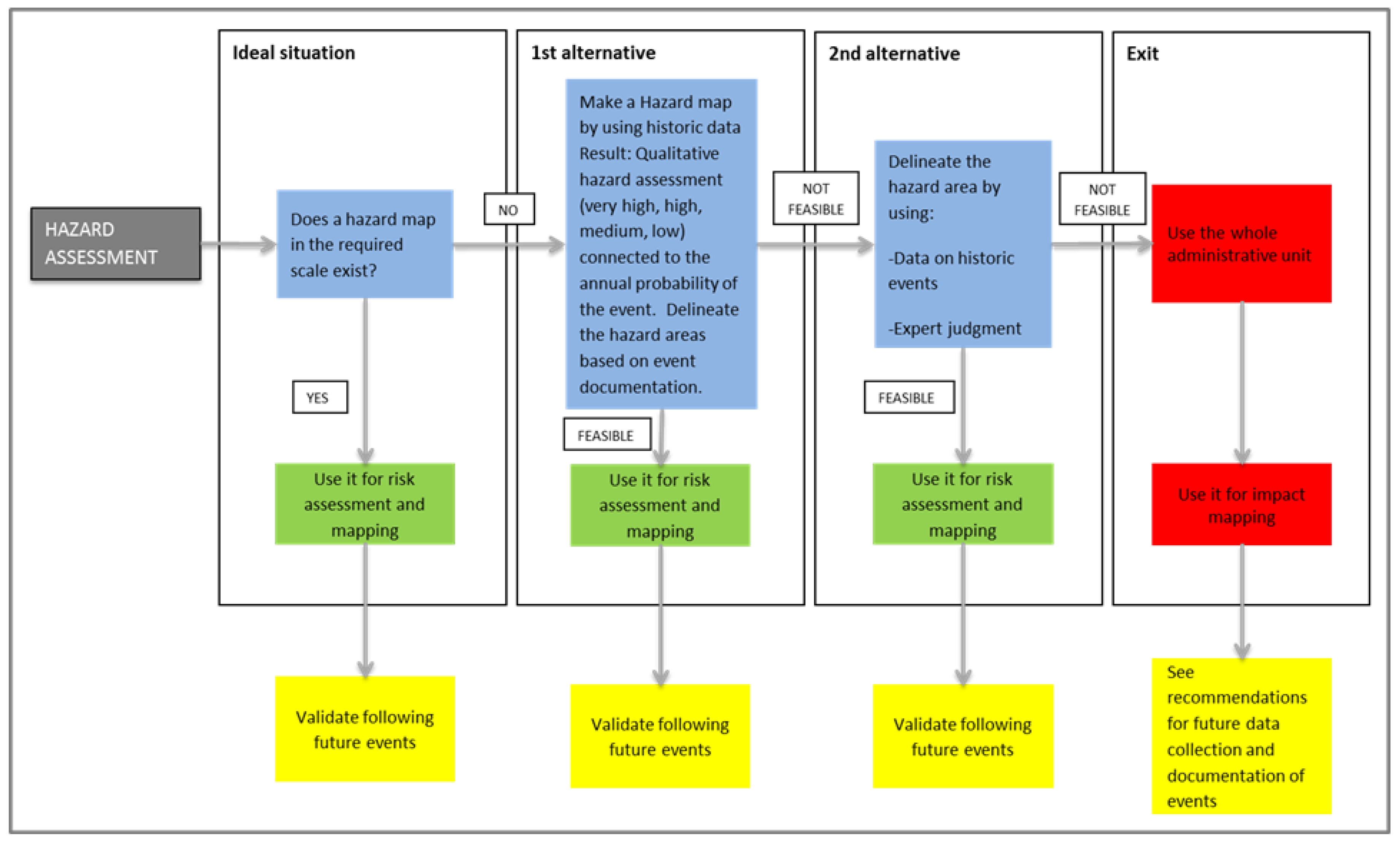
4.2.2. Quantitative Risk Analysis
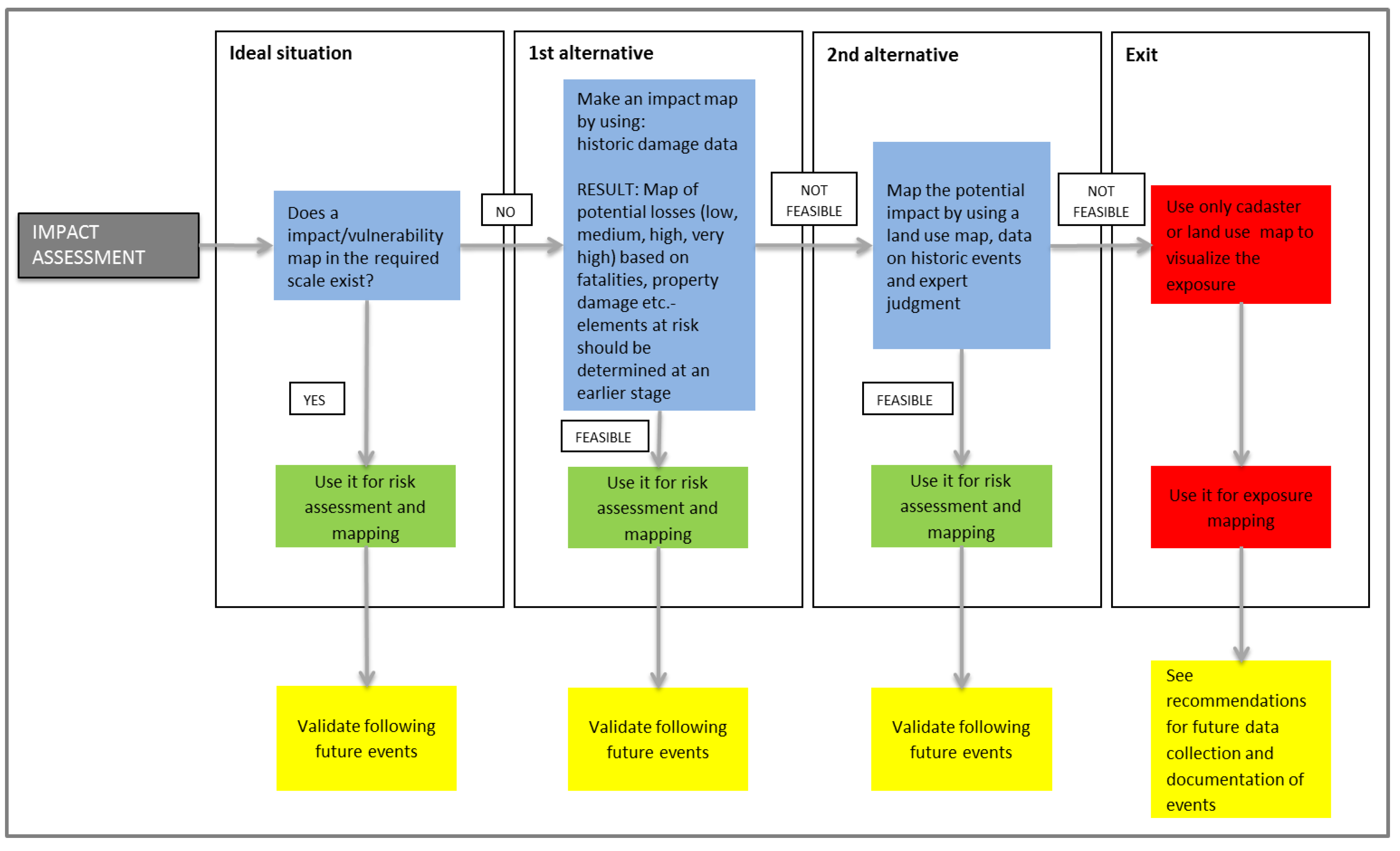
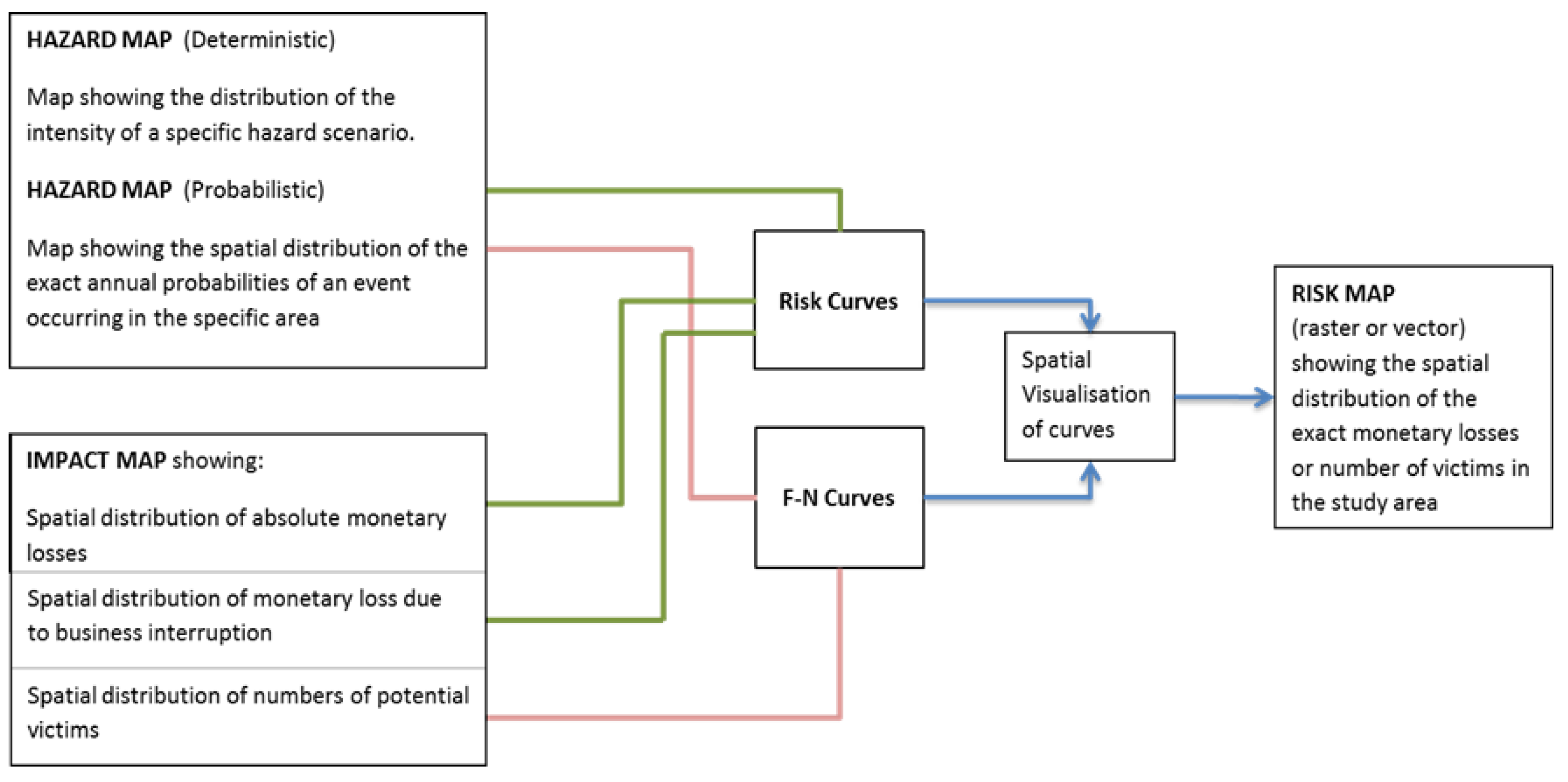
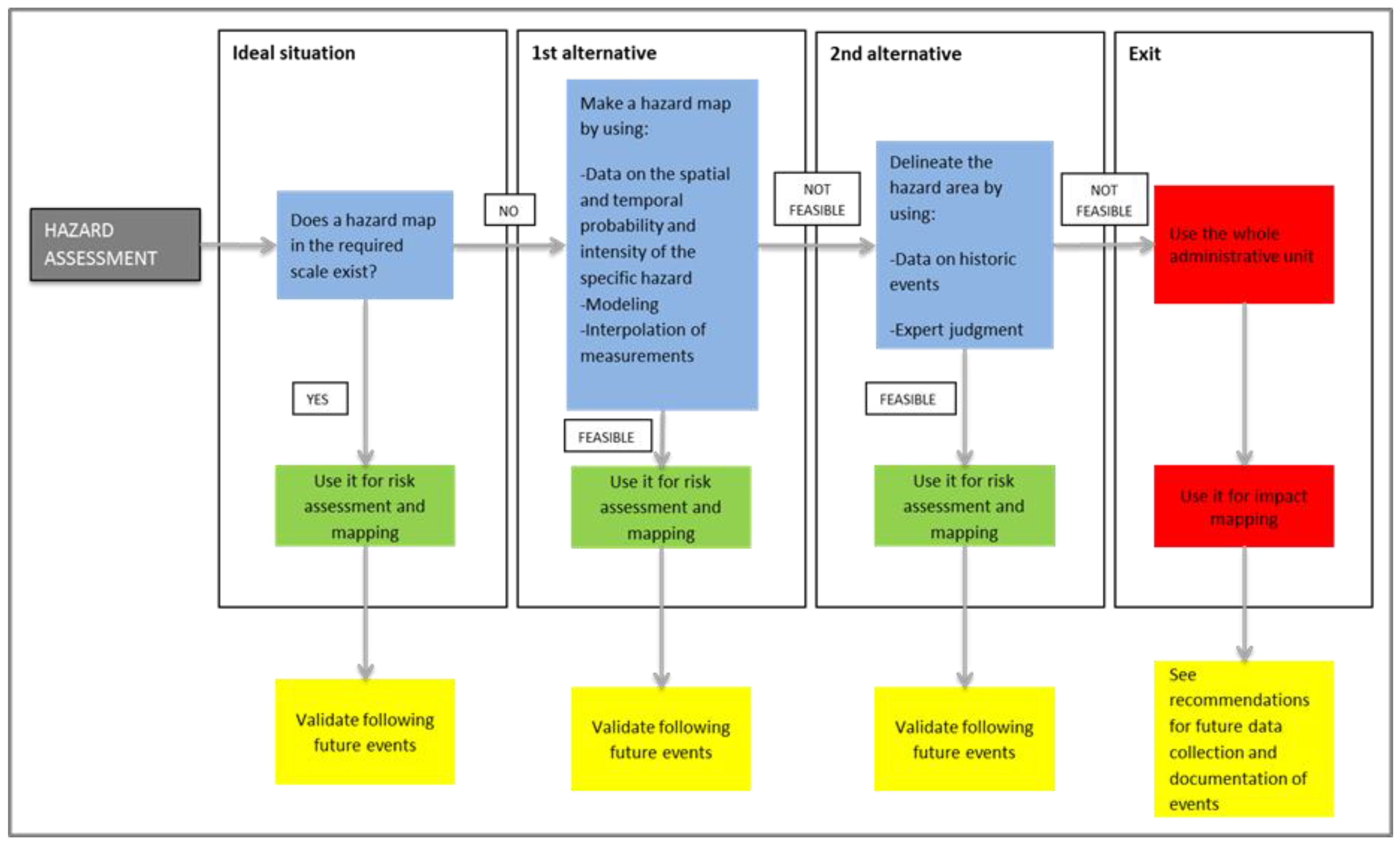

4.3. Risk Evaluation
4.4. Case Study Application for Specific Hazards
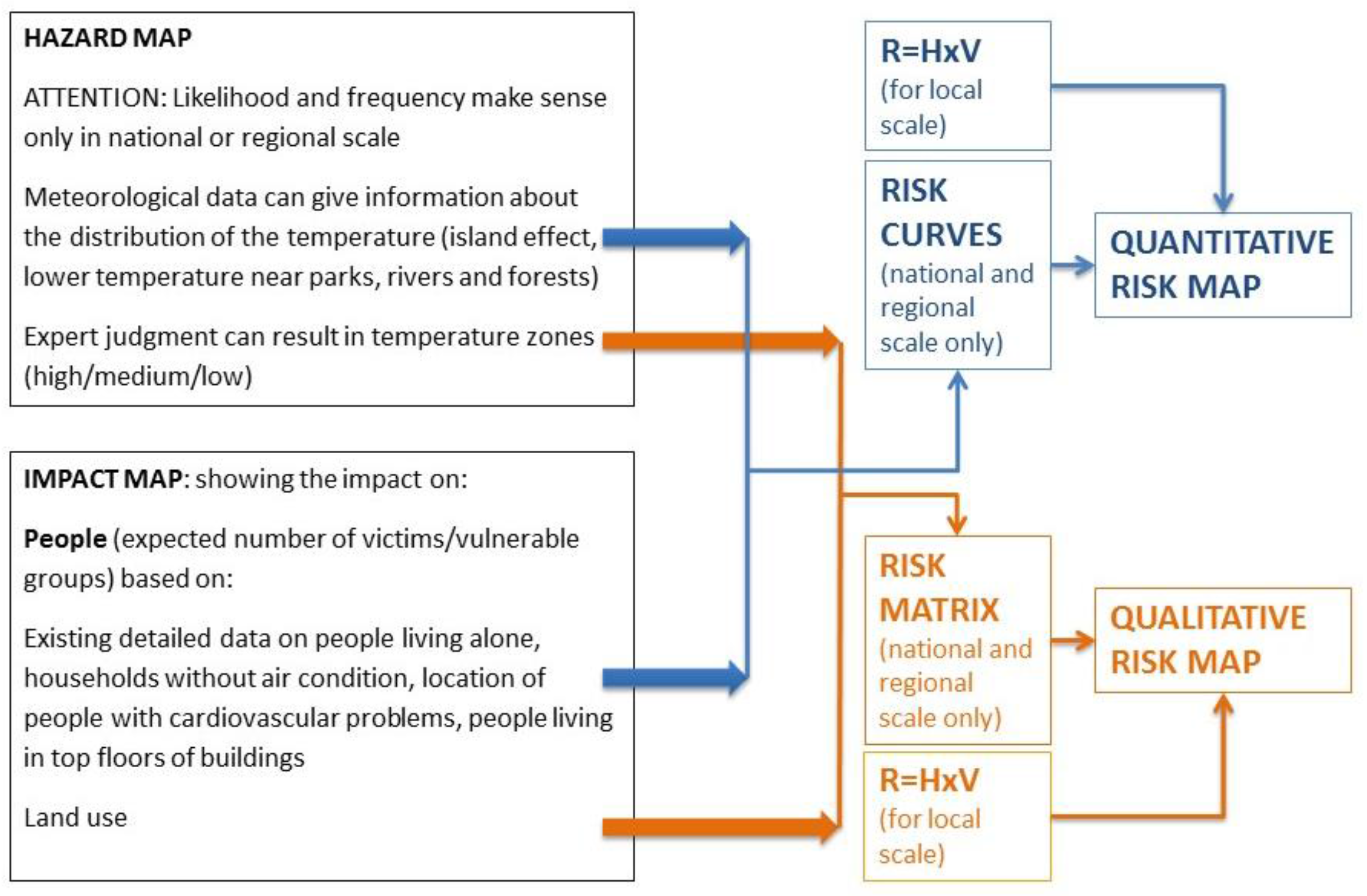
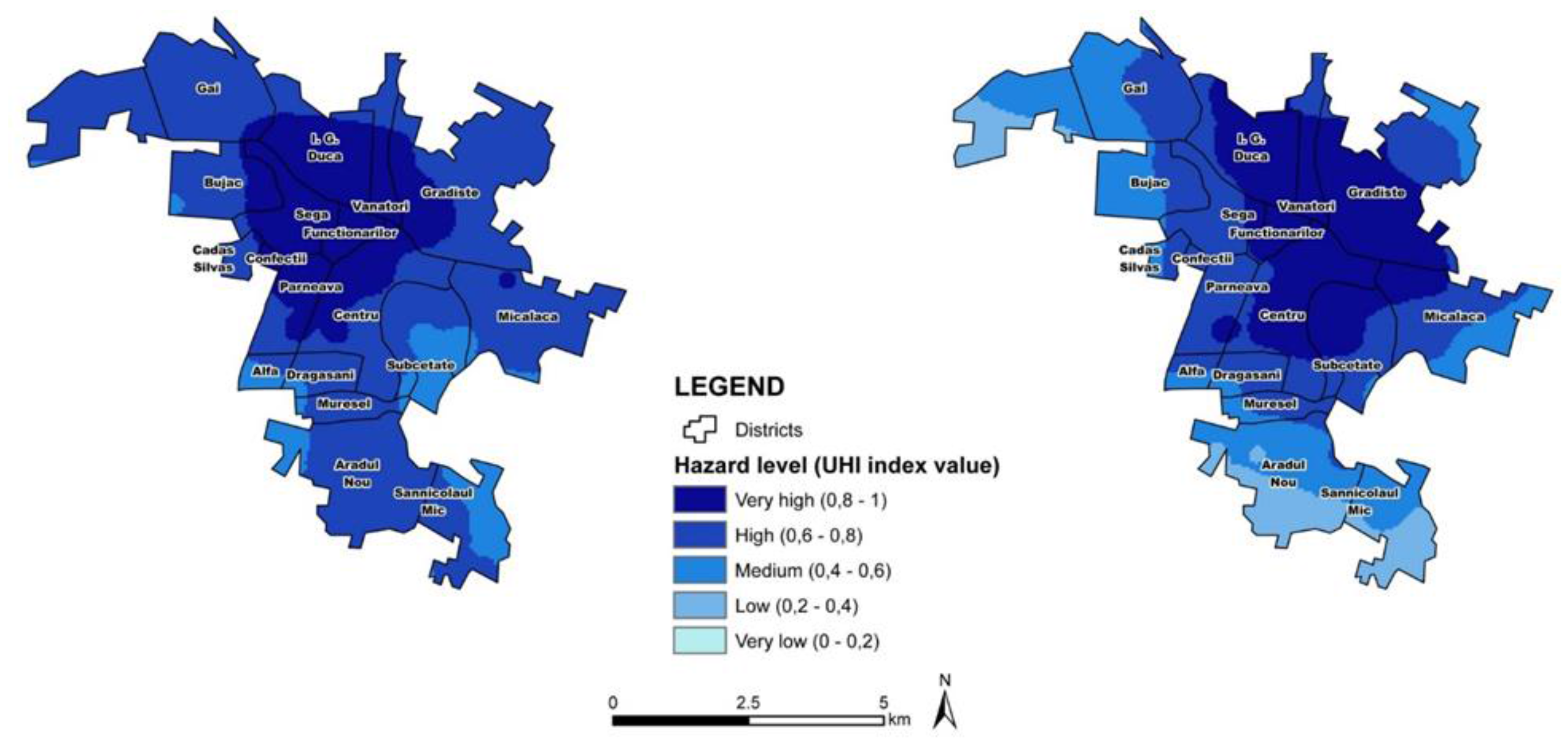
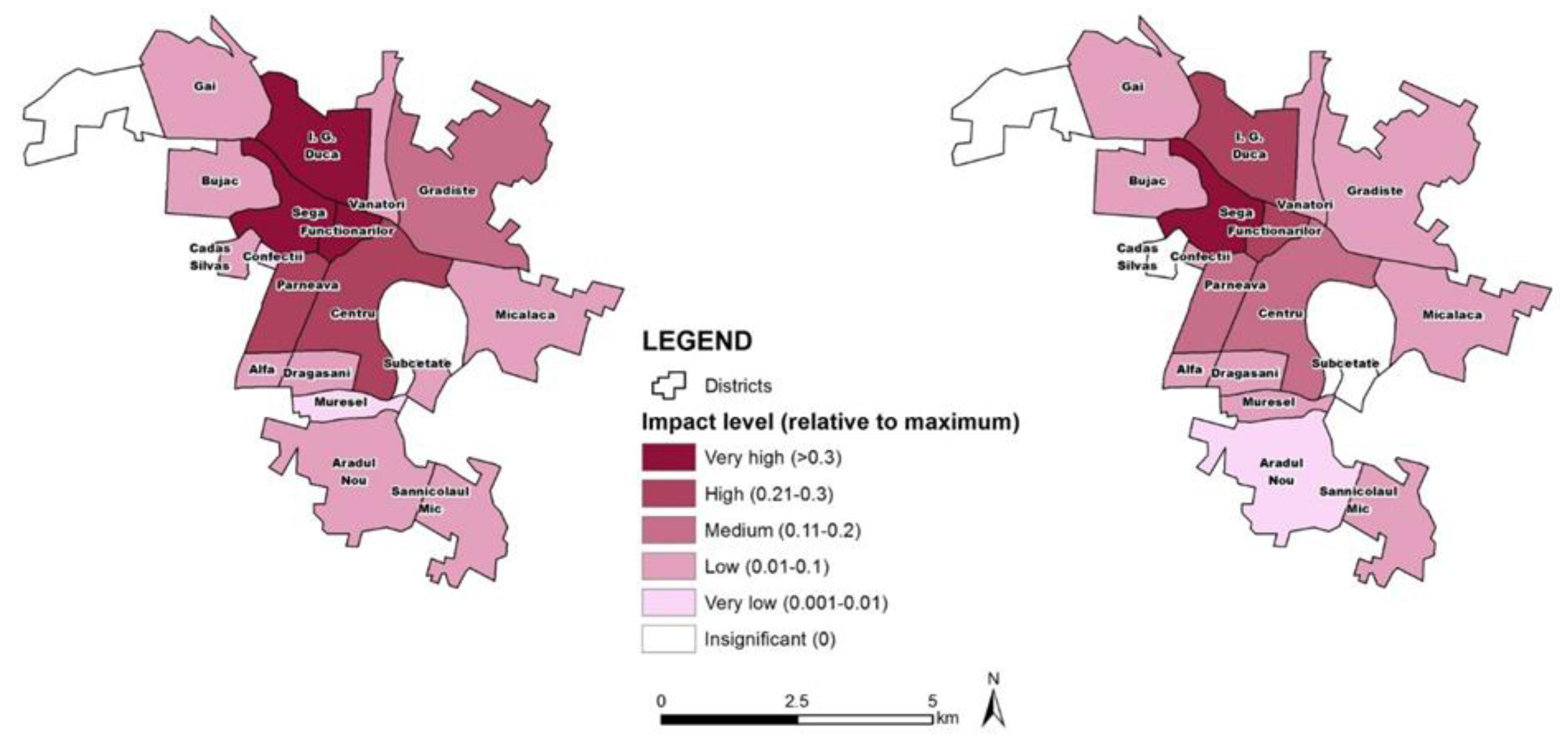
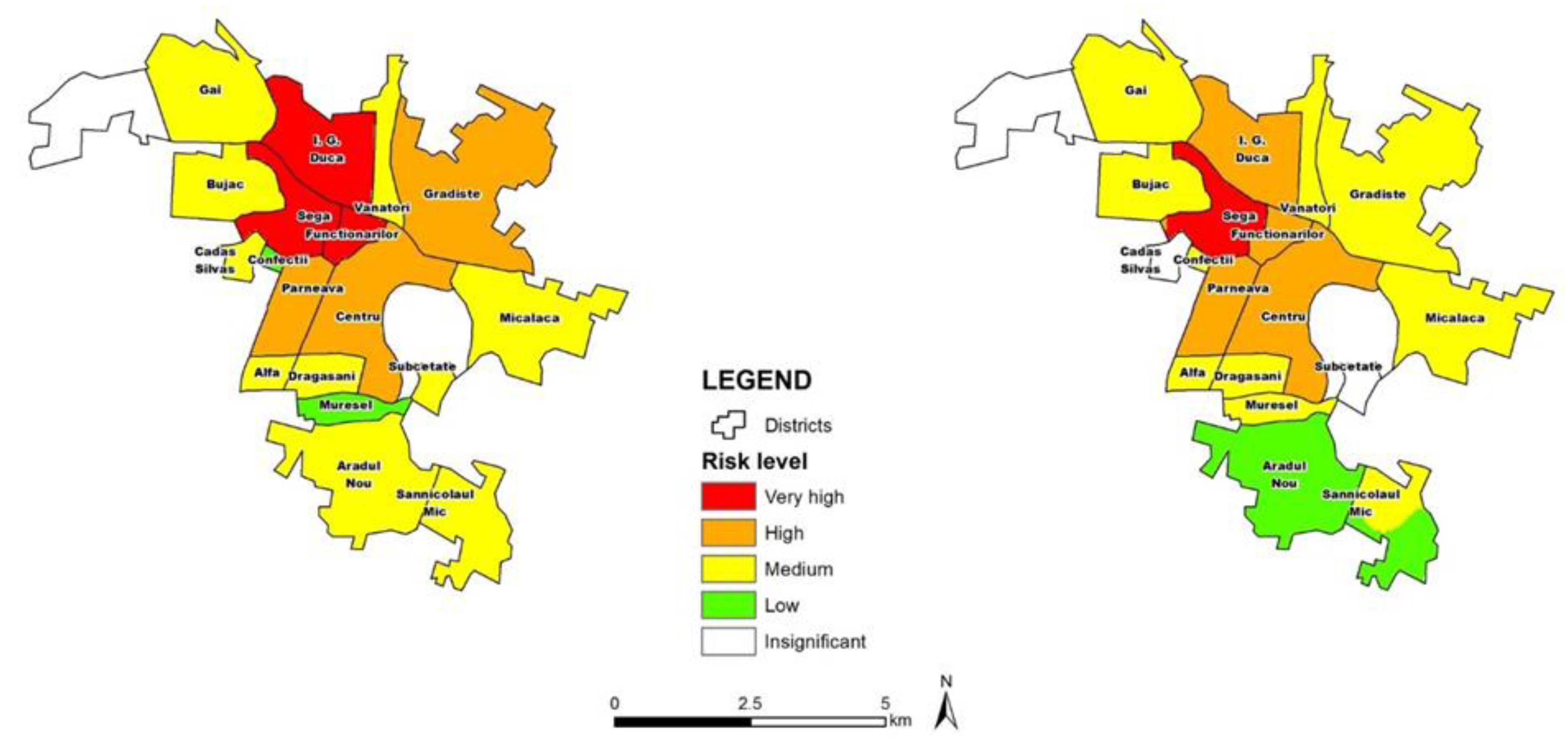
5. Discussion
5.1. Extension of CRAM to Include Scenario Analysis
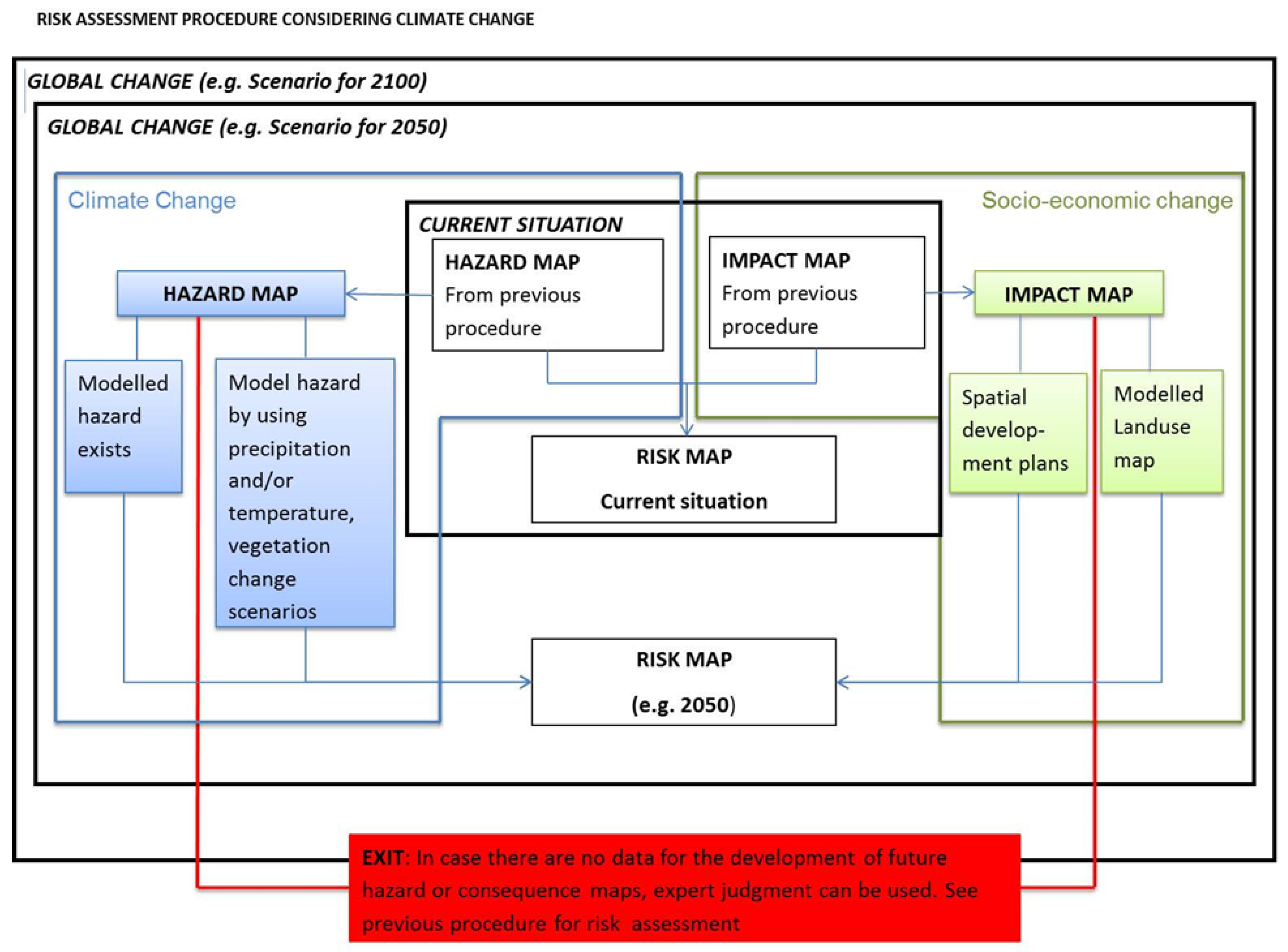
5.2. Benefits and Contribution
5.3. Limitations and Future Perspectives
- limitations related to the development of the methodology, and
- limitations related to the implementation of the methodology in the pilot areas.
6. Conclusions
Acknowledgments
Author Contributions
Conflicts of Interest
References
- Centre for Research on Epidemiology of Disasters (CRED). CRED Annual Disaster Statistical Review; University of Louvain: Brussels, Belgium, 2008. [Google Scholar]
- Dominey-Howes, D. Explainer: Are Natural Disasters on the Rise? The Conversation. Available online: https://theconversation.com/explainer-are-natural-disasters-on-the-rise-39232 (accessed on 23 November 2015).
- International Strategy for Disaster Reduction (ISDR). Terminology on Disaster Risk Reduction; UNISDR: Genève, Switzerland, 2009. [Google Scholar]
- Intergovernmental Panel for Climate Change (IPCC). Climate Change 2014 Synthesis Report Summary for Policymakers; Cambridge University Press: Cambridge, UK, 2014. [Google Scholar]
- Intergovernmental Panel for Climate Change. Managing the Risks of extreme Events and Disasters to Advance Climate Change Adaptation. A special report of Working groups I and II of the Intergovernmental Panel on Climate Change; Field, C.B., Barros, V., Stocker, T.F., Dahe, Q., Dokken, D.J., Ebi, K.L., Mastrandrea, M.D., Mach, K.J., Plattner, G.K., Allen, S.K., et al., Eds.; Cambridge University Press: Cambridge, UK, 2012; p. 582. [Google Scholar]
- Alcantara-Ayala, I.; Altan, O.; Baker, D.; Briceno, S.; Cutter, S.; Gupta, H.; Holloway, A.; Ismail-Zadeh, A.; Jimenez Diaz, V.; Johnston, D.; et al. Disaster Risks Research and Assessment to promote Risk Reduction and Management; ICSU: Paris, France; p. 49.
- Lei, Y.; Wang, J. A preliminary discussion on the opportunities and challenges of linking climate change adaptation with disaster risk reduction. Nat. Hazards 2014, 71, 1587–1597. [Google Scholar] [CrossRef]
- Gero, A.; Méheux, K.; Dominey-Howes, D. Integrating community based disaster risk reduction and climate change adaptation: examples from the Pacific. Nat. Hazards Earth Syst. Sci. 2011, 11, 101–113. [Google Scholar] [CrossRef]
- Gero, A.; Méheux, K.; Dominey-Howes, D. Integrating disaster risk reduction and climate change adaptation in the Pacific. Clim. Dev. 2011, 3, 310–327. [Google Scholar] [CrossRef]
- International Strategy for Disaster Reduction. Adaptation to Climate Change by Reducing Disaster risks: Country Practices and Lessons; Briefing Note 02; UNISDR: Genève, Switzerland, 2009. [Google Scholar]
- Mekong River Commission. Review of Climate Change Adaptation Methods and Tools; MRC Technical Paper No. 34; Mekong River Commission: Vientiane, Laos, 2010. [Google Scholar]
- Hare, M.C.; van Bers, J.M. (Eds.) A Best Practices Notebook for Disaster Risk Reduction and Climate Change Adaptation: Guidance and Insights for Policy and Practice from the CATALYST Project; TWAS: Trieste, Australia, 2013.
- Deutsche Gesellschaft für Technische Zusammenarbeit (GTZ). International Workshop on Mainstreaming Adaptation to Climate Change: Guidance and Tools; GTZ: Berlin, Germany, 2009. [Google Scholar]
- Tearfund. Linking Climate Change Adaptation and Disaster Risk Reduction; Tearfund: London, UK, 2008. [Google Scholar]
- International Federation of Red Cross and Red Crescent Societies. A Guide to Mainstreaming Disaster Risk Reduction and Climate Change; IFRC: Geneva, Switzerland, 2013. [Google Scholar]
- Mitchell, T.; van Aalst, M.; Villanueva, P.S. Assessing Progress on Integrating Disaster Risk Reduction and Climate Change Adaptation in Development Processes; Strengthening Climate Resilience Discussion Paper 2; Institute of Development Studies: Brighton, UK, 2010. [Google Scholar]
- Kellett, J.; Caravani, A. Financing Disaster Risk Reduction: A 20 Year Story of International Aid; Global Facility for Disaster Reduction and Recovery (GFDRR) and Overseas Development Institute (ODI): Washington, DC, USA, 2013. [Google Scholar]
- O’Brien, K.M.; Pelling, A.; Patwardhan, S.; Hallegatte, A.; Maskrey, T.; Oki, U.; Oswald-Spring, T.; Wilbanks, P.Z.; Yanda, F. Toward a sustainable and resilient future. In Managing the Risks of Extreme Events and Disasters to Advance Climate Change Adaptation; Field, C.B., Barros, V., Stocker, T.F., Qin, D., Dokken, D.J., Ebi, K.L., Mastrandrea, M.D., Mach, K.J., Plattner, G.K., Allen, S.K., et al., Eds.; Cambridge University Press: Cambridge, UK; pp. 437–486.
- United Nations. Sendai Framework for Disaster Risk Reduction 2015–2030; UNISDR: Genève, Switzerland, 2015. [Google Scholar]
- Birkmann, J.; von Teichman, K. Integrating disaster risk reduction and climate change adaptation: Key challenges-scales, knowledge and norms. Sustain. Sci. 2010, 5, 171–184. [Google Scholar] [CrossRef]
- Serrao-Neumann, S.; Crick, F.; Harman, B.; Schuch, G.; Low Choy, D. Maximizing synergies between disaster risk reduction and climate change adaptation: Potential enablers for improved planning outcomes. Environ. Sci. Policy 2015, 20, 46–61. [Google Scholar] [CrossRef]
- Begum, R.A.; Sarkar, M.S.K.; Jaafar, A.H.; Pereira, J.J. Toward conceptual frameworks for linking disaster risk reduction and climate change adaptation. Int. J. Disaster Risk Reduct. 2014, 10, 362–373. [Google Scholar] [CrossRef]
- European Forum for Disaster Risk Reduction. How Does Europe Link DDR and CCA? UNISDR: Genève, Switzerland, 2013. [Google Scholar]
- Mercer, J.; Dominey-Howes, D.; Kelman, I.; Lloyd, K. The potential for combining Indigenous and Western Knowledge in reducing vulnerability to environmental hazards in Small Island Developing States. Environ. Hazards 2007, 7, 245–259. [Google Scholar] [CrossRef]
- International Strategy for Disaster Reduction (ISDR). Strengthening Climate Change Adaptation through Effective Disaster Risk Reduction; Briefing Note 03; UNISDR: Genève, Switzerland, 2010. [Google Scholar]
- European Commission. Risk Assessment and Mapping Guidelines for Disaster Management; University of Louvain: Brussels, Belgium, 2008. [Google Scholar]
- United Nations Disaster Relief Organisation (UNDRO). Disaster Prevention and Mitigation—A Compendium of Current Knowledge; United Nations: New York, NY, USA, 1984. [Google Scholar]
- Wisner, B.; Blaikie, P.; Cannon, T.; Davis, I. At Risk: Natural Hazards, Peoples Vulnerabilities and Disasters; Psychology Press: Hove, UK, 2004. [Google Scholar]
- European Council. An EU Strategy on Adaptation to Climate Change; European Council: Brussels, Belgium; 2013. [Google Scholar]
- European Council. Commission Staff Working Document: Guidelines on Developing Adaptation Strategies; SWD European Council: Brussels, Belgium, 2013. [Google Scholar]
- Malet, J.P.; Remaitre, A.; Puissant, A.; Spickermann, A.; Glade, T.; Promper, C.; Petschko, H.; Begueria, S.; Sanchez, G. ChangingRISKS: Changing pattern of landslide risks as a response to global changes in mountain areas. In Proceedings of the CIRCLE2 Climate Impact Research & Response Coordination for a Larger Europe EU FP7 ERA-NET Mid-Term Meeting, Innsbruck, Austria, 29–30 March 2012.
- Commission of the European Communities. Green Paper from the Commission to the Council, the European Parliament, the European Economic and Social Committee and the Committee of the Regions-Adapting to climate change in Europe-options for EU Action; European Council: Brussels, Belgium, 2007. [Google Scholar]
- ICPDR & ISRBC (International Commission for the Protection of the Danube River and International Sava River basin Commission). Floods in May 2014 in the Sava River Basin: Brief Overview of Key Events and Lessons Learnt; ICPDR & ISRBC: Vienna, Austria, 2015. [Google Scholar]
- UNISDR. South Eastern Europe Disaster Risk Mitigation and Adaptation Initiative; Risk Assessment for South East Europe: Desk Study Review; UNISDR: Genève, Switzerland, 2008. [Google Scholar]
- UNISDR. Building Resilience to Disasters in Western Balkans and Turkey (Brochure); UNISDR: Genève, Switzerland, 2012. [Google Scholar]
- European Council. EU Directive of the European Parliament and of the European Council on the Estimation and Management of Flood Risks (2007/60/EU). European Council: Brussels, Belgium, 2007. [Google Scholar]
- CENN/ITC. Atlas of Natural Hazards and Risk Management of Georgia. CENN/ITC: Tbilisi, Georgia, 2012. [Google Scholar]
- Varazanashvili, O.; Tsereteli, N.; Amiranashvili, A.; Tsereteli, E.; Elizbarashvili, E.; Dolidze, J.; Qaldani, L.; Saluqvadze, M.; Adamina, S.; Arevadze, N.; Gvencadze, A. Vulnerability, hazards and multiple risk assessment for Georgia. Nat. Hazards 2012, 64, 2021–2056. [Google Scholar] [CrossRef]
- Balzer, D.; Jäger, S.D. Guidebook for Assessing Risk Exposure to Natural Hazards in Central America—El Salvador, Guatemala, Honduras, and Nicaragua. BGR: Hannover, Germany, 2010. [Google Scholar]
- Danube Floodrisk. Danube Atlas 2012: Atlas of Flood Hazard and Risk Maps of the Danube. ICPDR: Bucharest, Romania, 2012. [Google Scholar]
- Haupter, B.; Heiland, P.; Neumüller, J. Interregional and transnational co-operation in river basins—Chances to improve flood risk management? Nat. Hazards 2005, 36, 5–24. [Google Scholar] [CrossRef]
- Cechet, R.P.; Sanabria, A.; Yang, T.; Arthur, W.C.; Wang, C.H.; Wang, X. An assessment of severe wind hazard and risk for Queensland’s Sunshine Coast Region. In Proceedings of the International Congress on Modelling and Simulation, Perth, Australia, 12–16 December 2011; pp. 2817–2823.
- Jung, J.; Kim, C.; Jayakumar, S.; Kim, S.; Han, S.; Kim, D.H.; Heo, J. Forest fire risk mapping of Kolli Hills, India, considering subjectivity and inconsistency issues. Nat. Hazards 2013, 65, 2129–2146. [Google Scholar] [CrossRef]
- Ferrier, N.; Haque, C.E. Hazard risk assessment methodology for emergency managers: A standardized framework for application. Nat. Hazards 2003, 28, 271–290. [Google Scholar] [CrossRef]
- Hsu, W.K.; Huang, P.C.; Chang, C.C.; Chen, C.W.; Hung, D.M.; Chiang, W.L. An integrated flood risk assessment model for property insurance industry in Taiwan. Nat. Hazards 2011, 58, 1295–1309. [Google Scholar] [CrossRef]
- SEERISK. Guideline on Climate Change Adaptation and risk Assessment in the Danube Macro-Region. NDGDM: Budapest, Hungary, 2014. [Google Scholar]
- IEC. FDIS 31010: Risk Management—Risk Assessment Techniques. IEC: Geneva, Switzerland, 2009. [Google Scholar]
- Kohler, A.; Jülich, S.; Bloemertz, L. Guidelines: Risk Analysis—A Basis for Disaster Risk Management, German Technical Cooperation GmbH (GTZ); German Federal Ministry for Economic Cooperation and Development (BMZ): Eschborn, Gemany, 2004.
- AEMC. National Emergency Risk Assessment Guidelines; Australian Emergency Management Committee, Emergency Tasmanian State Emergency Service: Hobart, Australia, 2010. [Google Scholar]
- Papathoma-Köhle, M.; Promper, C.; Bojariu, R.; Cica, R.; Sik, A.; Perge, K.; Laszlo, P.; Balazs Czikora, E.; Dumitrescu, A.; Turcus, C.; et al. A common methodology for risk assessment and mapping for Southeast Europe: An application for heat wave risk in Romania. In Vulnerability Assessment in Natural Hazard Risk: A Dynamic Perspective; Special Publications; The Geological Society: London, UK, 2016; in press. [Google Scholar]
- USAID. A Review of Downscaling Methods for Climate Change Projections: African and Latin American Resilience to Climate Change Project. USAID: Washington, DC, USA, 2014. [Google Scholar]
© 2016 by the authors; licensee MDPI, Basel, Switzerland. This article is an open access article distributed under the terms and conditions of the Creative Commons by Attribution (CC-BY) license (http://creativecommons.org/licenses/by/4.0/).
Share and Cite
Papathoma-Köhle, M.; Promper, C.; Glade, T. A Common Methodology for Risk Assessment and Mapping of Climate Change Related Hazards—Implications for Climate Change Adaptation Policies. Climate 2016, 4, 8. https://doi.org/10.3390/cli4010008
Papathoma-Köhle M, Promper C, Glade T. A Common Methodology for Risk Assessment and Mapping of Climate Change Related Hazards—Implications for Climate Change Adaptation Policies. Climate. 2016; 4(1):8. https://doi.org/10.3390/cli4010008
Chicago/Turabian StylePapathoma-Köhle, Maria, Catrin Promper, and Thomas Glade. 2016. "A Common Methodology for Risk Assessment and Mapping of Climate Change Related Hazards—Implications for Climate Change Adaptation Policies" Climate 4, no. 1: 8. https://doi.org/10.3390/cli4010008
APA StylePapathoma-Köhle, M., Promper, C., & Glade, T. (2016). A Common Methodology for Risk Assessment and Mapping of Climate Change Related Hazards—Implications for Climate Change Adaptation Policies. Climate, 4(1), 8. https://doi.org/10.3390/cli4010008





